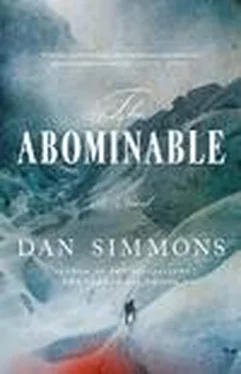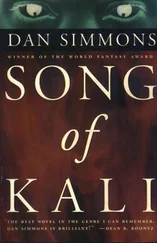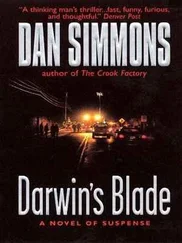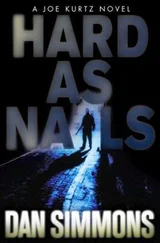The problem—as life-and-death challenges are so cutely called in mountain-climbing circles—was just too damned hard to solve. Especially at this impossible altitude. And especially for a man with broken glass in his throat. This entire Second Step consisted of amalgams of rock that wore away much more slowly than the shale and other stone beneath it.
The first ten yards or so of the 90 feet of cliff would probably go, because there were various tumbled boulders, rock extrusions, and smaller cracks on the lower third of this six-mile-high impossibility. A groove between the largest of those boulders and the cliff face angling east from it might work, with perfect rock climbing and a serious expenditure of energy, but I’d have to step out and balance atop that damned boulder before attempting the second pitch of the three-section climb.
This first pitch between the boulders and the cliff face and then smack dab atop the boulders onto the steep snowfield would have been a challenging but fun afternoon’s scramble in Wales near Pen-y-Pass. I couldn’t imagine the amount of energy it was going to require at 28,246 feet.
But I kept looking—trying to figure the best route. If there was a “best route.” Neither premier rock climber next to me, not Jean-Claude, not the Deacon, said a word to interrupt my thinking. In truth, probably neither of them had so workable a route either.
From somewhere atop that big boulder some 30 feet and change up the cliff, there would be a high, risky step onto a steep snow band or—more appropriately—steep cone of snow, on which I’d have to traverse steeply uphill and back to the central crack where the cliff here met the face at almost a right angle. God knows whether that cone-shaped snow patch would stay on the cliff or avalanche off with me on it. Then, if I made it back to a point higher on the central crack, I’d have to learn how to levitate like a Buddhist holy man to get to the base of the final and most impossible third of the climb.
The “crack” looked to be a fissure never wide enough for my body to wedge in sideways and in most places not much wider than the flat of my hand. Another crack, much smaller, ran in tree-shaped fracture lines upwards at odd, probably unusable angles from the snowy jump-off point.
This last, vertical pitch of the climb was the killer—almost certainly in the literal sense.
Those last 20 feet or so would be listed in the “Extremely Difficult” category in any country’s or continent’s method of rating climbs—what we today in the spring of 1991 as I write this would label a 5.9 or 5.10 climb—a pitch requiring not only great expertise but absolute commitment even to attempt. Absolute commitment or a simple death wish.
And that near-impossible difficulty rating was for sea-level climbing. How would it be rated here at more than 28,200 feet above sea level?
How could I say to the Deacon and Jean-Claude and Reggie and Pasang the simple sentence “I can’t do this”? Not just because I was getting about a third the amount of air I should be getting through my frozen and clogged and pain-wracked throat and frozen upper respiratory system, but because I couldn’t do the fucking last 20 feet of this sort of pitch problem on a summer day in Massachusetts if the face were ten feet off the ground with mattresses spread around beneath me, much less here, more than 8,000 vertical feet above the East Rongbuk Glacier.
No one could do it. At that moment I was certain that George Leigh Mallory couldn’t have done it and didn’t do it. I was certain that Mallory and Irvine must have taken one close-up look and turned around here at the Second Step. Whatever delay had made it necessary for them to scramble down through the rock ledges below the Yellow Band down there after sunset, I was absolutely sure at that moment that it had not included time they’d taken to climb and then later down-climb this Second Step.
It was impossible.
“How do you see it, mon ami? ” Jean-Claude asked.
I coughed and cleared my throat. “Start at the top of the snow pyramid,” I began, “about six to ten feet away from the face and big crack. Free-climb those boulders to that central boulder and up, chimney if I have to, and then take one goddamn big step onto that steep snowfield. Then try to traverse back to the central crack, use it and those fractures to get up to the vertical part, and then…well, I’ll figure it out when I get to that point.”
This sounds more solid and linear than it was delivered. I’d had to stop three times to cough, bending over for the last gut-ripping spasms.
“I agree on the route,” said the Deacon. “But do you feel up to doing this, Jake? Your cough is terrible and getting worse by the minute. I’d be happy to give it a go.”
I felt myself shaking my head. I’m not sure to this day whether I was saying No, I bloody damned well don’t feel like doing this impossible free climb and dying this way or whether I was insisting that I give the climb our first shot.
My friends interpreted it the second way.
I was down to Norfolk jacket, wool trousers, and my thin silk gloves now. Everything else had been crammed and lashed down into my rucksack. Absurdly, I’d pulled my thick wool cap so low down over my leather motorcycle helmet that it covered the goggles I’d pushed up on my forehead. During this climb—this climb of all climbs—I had to be able to look down and see my feet. My oxygen mask and goggles restricted my vision and made me feel too removed from this cold, windy top of the world. So no rucksack or oxygen or gas mask carryall or ice axe was coming with me. There would be nothing on my back to pull me off balance. I was keeping the crampons on because I’d learned to trust climbing with them on rock, but nothing else to get between the rock and my feel for the rock; nothing, that is, other than my illness and exhaustion and almost debilitating fear.
“You know,” I said almost conversationally to the Deacon and Reggie, my casualness broken only by my wheezing and coughing, “I did think of a way we might get out of all this with no more loss of life on either side.”
Both the Deacon and Reggie cocked an eyebrow and both waited.
“Let me go out with a white flag when Sigl and his boys show up,” I said between coughs, “and I’ll give them the photographs—maybe even the negatives, too.”
“Comment?” said Jean-Claude. He sounded shocked and disappointed.
“But we’d give them four of the envelopes and hide the fifth one somewhere here in these cracks and boulders,” I hurried to say…as much as one could hurry with so little oxygen getting to one’s aching lungs. “Keep one set for ourselves, you see.”
“And you’d give the Germans the negatives?” asked Reggie. I couldn’t interpret her expression.
I shrugged, which was easier to do with my outer layers off. But I was getting cold very quickly now.
“I know enough about photography to know that you can make a sort of new negative from actual prints…a ‘dupe,’ I think they call it,” I said as if it were not a matter of great interest or import for me, just a passing thought. “That way, Sigl and his goons might consider their mission fulfilled and we’d be left alive with all seven of the photos to share with…well, with whoever your mystery man is, the fellow who loves checks and gold. There’d be no reason for the Germans to kill us if they get what they want…what they came for two years in a row.”
The Deacon shook his head—sadly, I thought. “They’d kill us anyway, Jake. Even if they thought they had all the photographs, which they wouldn’t risk in the first place. Remember, they’ve killed almost all of our Sherpas this week as well as murdering Lord Percival Bromley and an Austrian boy last year. They couldn’t leave us alive to tell about all this.”
Читать дальше












